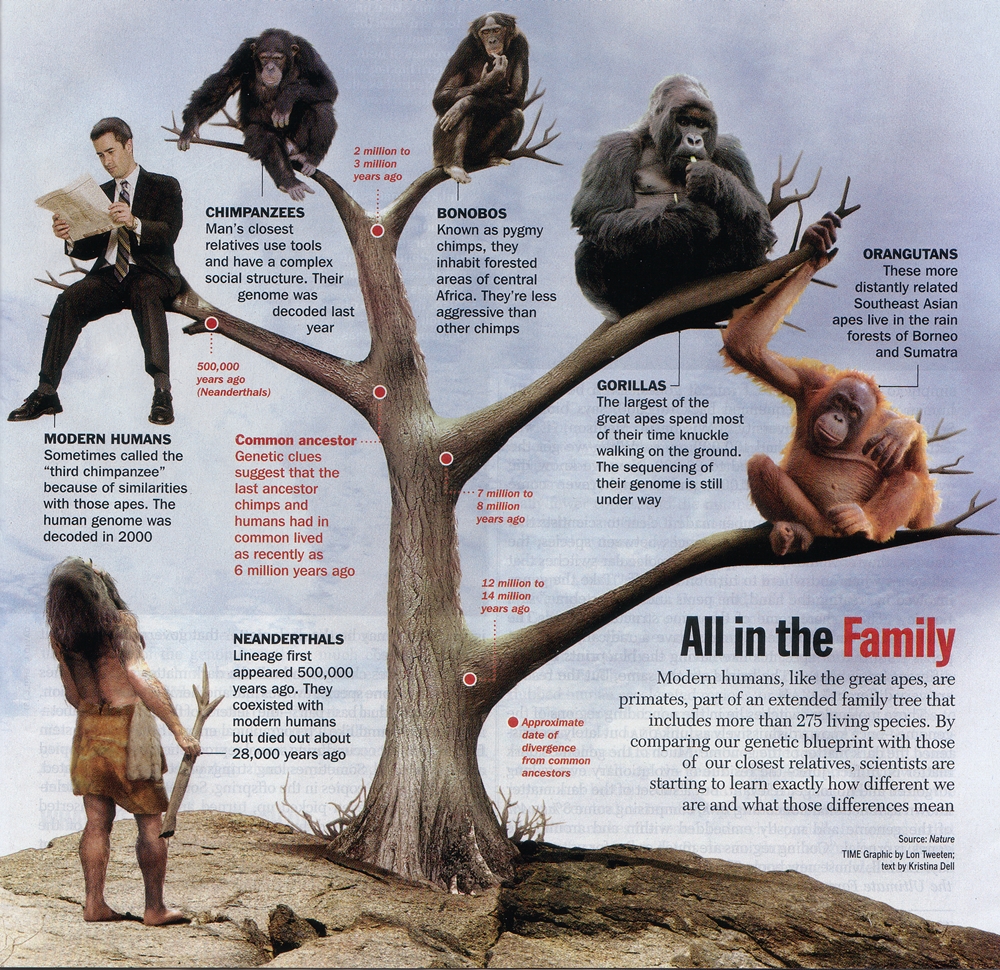

However, across about 3% of the human genome this relationship is unequal, where humans are closer to bonobos than they are to chimpanzees, while in others, humans are closer to chimpanzees (Prufer et al. As expected then, the genomes of bonobo and chimpanzee are mostly equally distant from human. Chimpanzees and bonobos last shared a common ancestor with each other about 1–1.5 mya. For instance, comparing the gorilla genome to those of human and chimpanzee suggested that across about 15% of their genome, gorillas share a closer relationship with humans than they do with chimpanzees (Scally et al. In particular, the genealogical relationships between humans and African apes vary across the genome. These studies suggest that the speciation process leading to the separation of the human-chimpanzee/bonobo-gorilla ancestor was quite complex, and that the separation of these lineages occurred so closely in time that they are difficult to disentangle. The lineage ultimately leading to modern humans separated from the lineages leading to chimpanzees and bonobos 5.5–7 million years ago (mya), from the lineage leading to gorillas 8.5–12 mya, and from the lineages leading to orangutans 9–13 mya.ĭetailed comparisons between the complete genomes of each species have recently been completed. Gorillas are a close second, sharing 98%, and orangutans come in third, sharing 97% of their genome with us. Chimpanzees and bonobos share 99% of their genomes with humans in regions of their genomes that can be directly aligned and compared. This consensus was bolstered by initial comparisons of the chimpanzee and human genomes (Consortium 2005). The general consensus that emerged is that we share a more recent relationship with chimpanzees ( Pan troglodytes) and bonobos ( Pan paniscus) than we do with gorillas ( Gorilla gorilla) (Ruvolo 1997, Chen & Li 2001). These studies also led to rich discussions about the suite of factors that may have contributed to promoting speciation in the last common ancestor of humans and African apes, as well as the factors that might have contributed to creating the amazing diversity of Hominins that co-existed with each other during the Pliocene and Pleistocene (Foley 2002).įor many years, there was considerable debate about which of the African apes is our closest relative.

Such studies also raised questions about which evolutionary processes generated the diversity found in great ape species, and about how these processes differ across species. The late 20 th century saw an explosion of genetic studies that offered great insights into the shared evolutionary history of humans and apes. Many types of data have been used to answer these questions, including morphological, genetic, ecological and behavioral data. A central focus of biological anthropology is to infer the evolutionary relationships that we share, to examine how our evolutionary history differs from apes, and, ultimately, to understand the unique adaptations that ‘make us human'. Of these, the African great apes, Pan and Gorilla, are our closest living relatives. The ape family, Hominidae, contains four extant genera: Pongo, consisting of the Sumatran and Bornean orangutans Gorilla, consisting of western and eastern gorillas Pan, consisting of common chimpanzees and bonobos and finally Homo, consisting of humans (Figure 1). Why is Studying Ape Speciation Important?


 0 kommentar(er)
0 kommentar(er)
